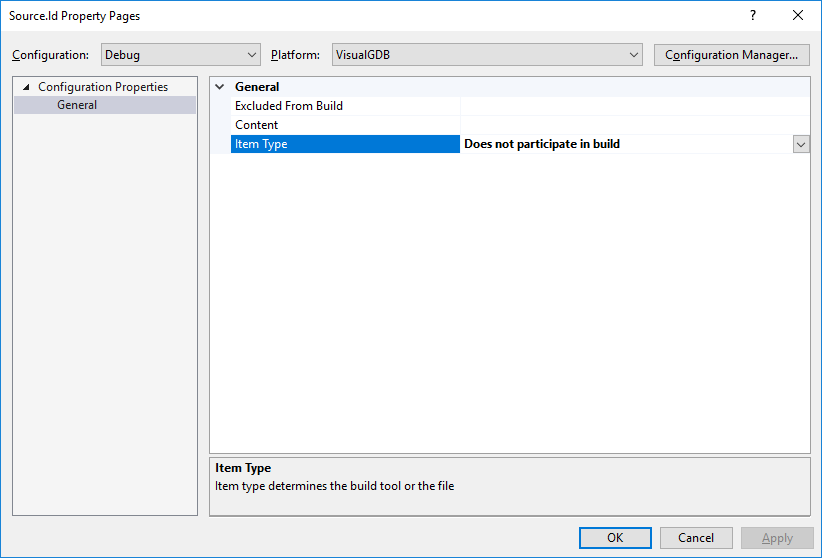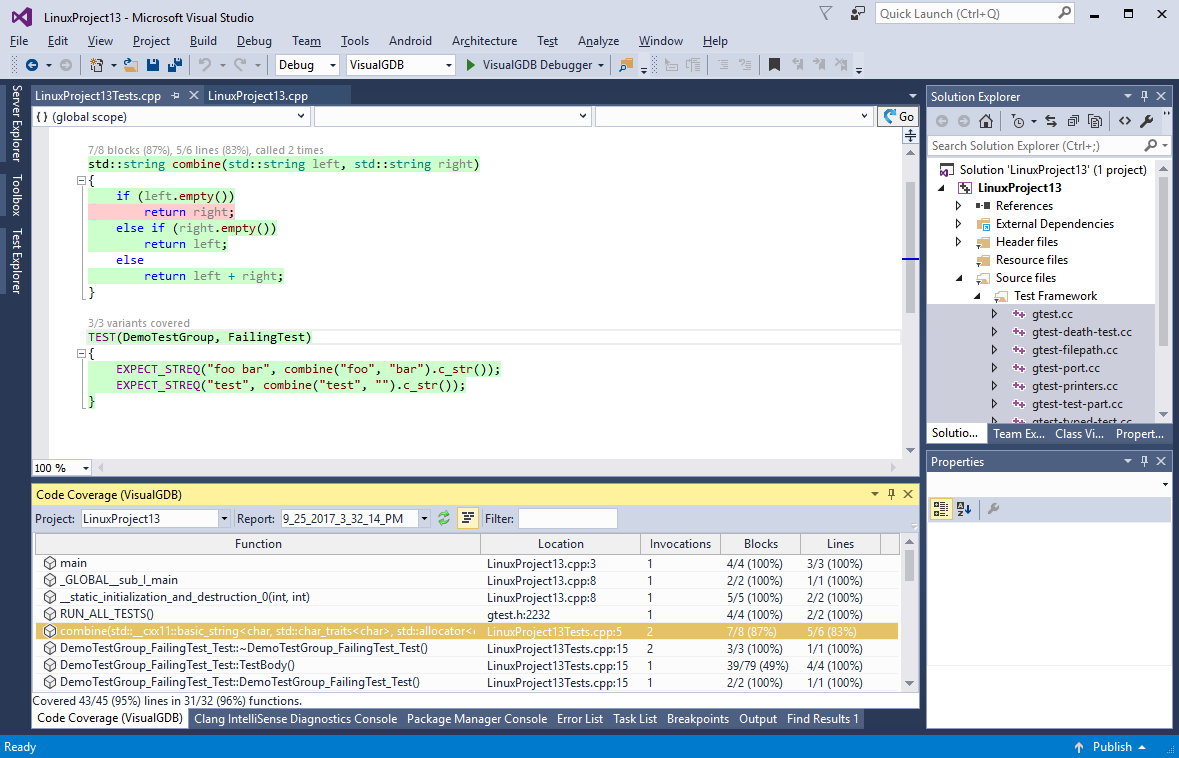Forum Replies Created
-
AuthorPosts
-
support
KeymasterHi,
The warning message is actually legitimate: you have included multiple .ld files in your project, but didn’t specify via VisualGDB Project Properties which one is the main one. VisualGDB arbitrarily guesses the first one (and guesses it wrong).
Please specify the linker script explicitly via VisualGDB Project Properties or change the file type of the unused linker script to “Does not participate in build”:

Attachments:
You must be logged in to view attached files.support
KeymasterHi,
We would advise switching the output to disassembly and checking the assembly code that got produced. Most likely the GCC optimizer has optimized out some instructions modifying global variables.
If this is the case, we would advise declaring those variables with the ‘volatile’ keyword to explicitly tell the optimizer that each access to them should be preserved.
support
KeymasterHi,
Please follow this tutorial to adjust the softdevice memory for Nordic devices: https://visualgdb.com/tutorials/arm/nrf51/softdevice_memory/
support
KeymasterHi,
This should normally be fixed by including the script in the template by adding it to the project before exporting it.
However previously you have mentioned that you cannot do this because the build system complains. Please provide us the details on any errors you encounter when you try to add the second script before exporting the template.
support
KeymasterHi,
Looks like you are trying to debug a project that is not built. Please build it first.
If it doesn’t help, please attach the entire gdb log as described here and we can help you understand what is going on.
support
KeymasterHi,
This is a known issue. The GCC compiler used by VisualGDB is not 100% compatible with the Keil compiler and uses a completely different syntax for placing parts of your program at fixed addresses.
We have a detailed tutorial explaining the entire process here: https://visualgdb.com/tutorials/arm/bootloader/
It is also worth mentioning that VisualGDB can be configured to use the Keil compiler instead of GCC. Please follow this tutorial for details: https://visualgdb.com/tutorials/arm/keil/
support
KeymasterHi,
Thanks, we have noted this down and will try to include support for running tests on MinGW in the next major build.
Regarding the code coverage, VisualGDB 5.3 actually works very well with gcov. You can simply enable coverage reports via VisualGDB Project Properties (it works only for Linux projects) and it will automatically run gcov, build a searchable coverage database and map file paths so that you can view coverage information directly in the code:

support
KeymasterHi,
Please, please, please always provide more details about the errors you encounter. We would absolutely love to help you, but it is almost impossible to guess what is going on without knowing the exact error messages. VisualGDB build system is complex and it could be broken by incorrect settings in tens of different options, each one resulting in a different error message. Unfortunately we cannot provide much help without knowing the exact message shown by the build system.
support
KeymasterNo problem, we can help you get GUI to work – this is 100% supported.
VisualGDB will only include a file in the template if both of the following holds for it:
- The file resides inside the project directory (or one of its subdirectories)
- The file is explicitly included in the project in Solution Explorer
E.g. the following files won’t be included:
- Any sources outside the project directory (with relative paths starting with ..\)
- Linker scripts unless you explicitly add them to SolutionExplorer and copy under the project directory
- Any header files included from your sources, but not present in Solution Explorer or residing outside the project directory
Hope this helps. If not, please let us know which file you are trying to include, where is it located and how does it look in Solution Explorer (i.e. its item type and relative path).
support
KeymasterHi,
OK, please try this build: http://sysprogs.com/files/tmp/VisualGDB-5.3.16.1933.msi
We have added new options under C/C++->Advanced:
- Additional Options (C files)
- Additional Options (C++ files)
support
KeymasterHi,
OK, that looks very much like the cycle counter is not available on your device or is not accessible from the software (that is the case on the STM32F7 devices we tested). Please follow the tutorial linked above to add a workaround – it’s very simple and involves overriding one function that will use one of the general-purpose timers for counting the cycles.
support
KeymasterHi,
Yes, the template allows adding sub-folders, however the folders shown in Solution Explorer don’t always correspond to the physical subfolders on the disk. VisualGDB automatically preserves both when creating/restoring templates, however if you want to edit the templates manually, please ensure you understand the difference between them as confusing the paths would make the template unreadable.
To diagnose corrupt templates, please download 7-Zip and run the following command line for both working and a broken templates:
7z.exe l <template file>
This will list the contents of both files. Please carefully compare the outputs for the 2 template files (and the unpacked template.xml files) and double-check all differences.
As we may change the internal template format in the future, we don’t provide specific instructions on editing it manually and don’t guarantee that this will always work, sorry. The only officially supported way of doing this is using VisualGDB template export GUI. We made the template format easily editable (zip+xml) to make advanced tweaking possible, however this is something to do purely at your own risk. If the inconvenience from troubleshooting accidentally broken templates doesn’t outweigh the advantages of manual tweaking, please don’t use this feature and use the GUI instead.
support
KeymasterHi,
You can add subfolders to the template file as long as you don’t move other files inside it. E.g. the template.xml file needs to be always in the root directory of the template.
Generally if you are not comfortable manually editing the templates, please rely on VisualGDB to generate them automatically – add all necessary files to the Visual Studio project and then create a template. Hacking the template files manually is possible, however is more error-prone than generating them automatically and we generally don’t recommend doing it unless you are ready to troubleshoot errors caused by unexpected modifications.
support
KeymasterHi,
Sorry for the confusion. The “diagnostics” page is shown in the “Live Profiling” window, not “Ream-time watch”.
Based on your last description, it looks like something is interfering with the instruction counter used by VisualGDB. Please try disabling the Chronometer (normally it should be disabled automatically when doing profiling or real-time watch). If it doesn’t help, your device may block the software from resetting the instruction count register (e.g. STM32F7 devices have this issue). In this case you would need to use a general-purpose timer instead (we have a detailed tutorial showing how to do that).
support
KeymasterHi,
Normally the –start-group and –end-group arguments should handle this automatically – force the linker to automatically reorder the libraries between those 2 statements. Perhaps you are using some very old version of the linker that doesn’t handle it properly? If this is the case, simply updating it may solve the problem.
If this doesn’t help, could you confirm that specifying -ludev just before –end-group still causes the problem?
-
AuthorPosts